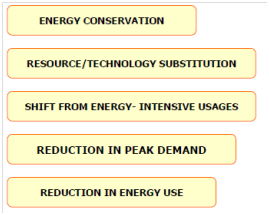What is Demand Side Management?
While the term may be used in a broader sense, here we shall explain it chiefly in terms of a utility-driven programme.
DSM is an intervention through a utility on the "customer side of the meter" to change the way customers use electricity.
It is used, commonly, to optimize available and planned generation resources and includes
- using existing energy supplies more efficiently and improving efficiency of energy use;
- Reduction in the total quantity of energy consumed through users through better load management;
- energy conservation measures for using lesser energy to generates same or greater output and minimizing losses in existing processes of energy production and use;
- resource and/or technology substitution, that is, altering the mix of a given energy system through replacing less efficient fuels with more efficient fuels or through introducing new technologies in which are more efficient;
- structural changes through shifting away from high energy-intensive industries to high capital- or labour-intensive industries or through changing lifestyles which encourage excessive energy consumption; and
- Reduction in the demand for energy (e.g., electricity or gas) at peak times while energy supply system is strained and to shift demand from peak to off-peak times.

Figure: Important Features of Demand Side Management
DSM could be achieved by
- enhancing energy efficiency, that is the reduction of kilowatt hours (kWh) of energy consumption, and
- demand load management, that is the reduction of kilowatts (kW) of power demand or the displacement of demand to off-peak times.
Programmes for awareness generation, customer or vendor rebates for efficient equipment and etc. belong to the first category that also involves technology changes and consumer behaviour changes. For example, an energy conservation measure such as replacing incandescent lights along with more efficient compact fluorescent bulbs is an example of a technology change. Same, using a thermostat operated electric geyser is a better technology option than the immersion rod for heating water. Consumer behaviour modifies such as reduced energy use or shift in the timings of appliance use can be brought about by a variety of incentives through the utility.
The second category involves measures such as peak clipping, strategic conservation or strategic load growth, load shifting, time-of-use tariffs, interruptible tariffs, direct load control, etc. We should discuss these aspects in greater detail here. There are several reasons why power utilities should adopt DSM activities, chiefly arising from its benefits. This is what you will learn now. But first you might like to fix the concept of DSM in your mind.